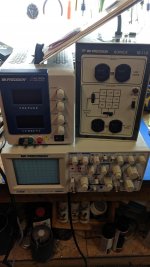So I have been working on several amps that are difficult for me, and learning a lot. During this time my poor old o-scope has been fighting me and making question what i am seeing and sometime I can't get it to lock in on a signal I know should be there. Been saving my pennies for a new digital scope, even though I would like to get a analog. Well... this fell into my lap tonight (all three pieces, with manuals, like new) for half of what I was saving up for a cheaper digital scope. I am doing the happy dance. (please note the universe has already punished me, my truck broke down on the way home from getting this, LOL such is life)
Attachments
Please don't use the isolation transformer to float the ground on your scope.
You did far better with that analog scope than you would with most digital scopes with an LCD display. The CRT display will give you a sharp, clean image of the waveform, not something that looks like a handheld video game from the 80's.
The split supply will work well to run the output stages on low voltage (main rectifiers removed) to troubleshoot amps that randomly do bad things.
You did far better with that analog scope than you would with most digital scopes with an LCD display. The CRT display will give you a sharp, clean image of the waveform, not something that looks like a handheld video game from the 80's.
The split supply will work well to run the output stages on low voltage (main rectifiers removed) to troubleshoot amps that randomly do bad things.
The isolation transformer and the power supply were just part of the deal. I have repaired some home audio equipment, and back in the day some CRT TV's. Not sure what I would use it for now days on modern electronics, but glad to have it. The power supply is only 3 amp 0-30V, but its nice to have a current limiting supply now, instead of only having a fuse and resistor. It should be a treat on small amps, heck really anything that idles at less than 3 amps it will work!
If you've seen any of the repairs that used low voltage (or the mention of it in the tutorial), it will be much more useful as the secondary, low voltage supply. Using the low voltage also lets you see the low drive at much higher resolution (using DC coupling) since the scope is only set to 5v/div instead of 20 or 50v/div.
- Status
- This old topic is closed. If you want to reopen this topic, contact a moderator using the "Report Post" button.
